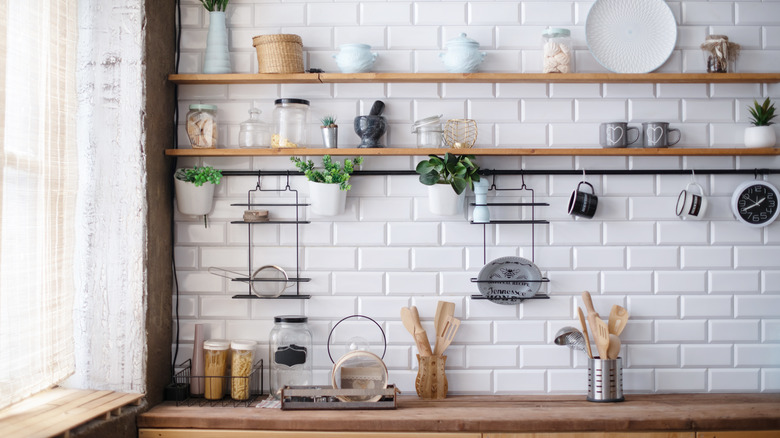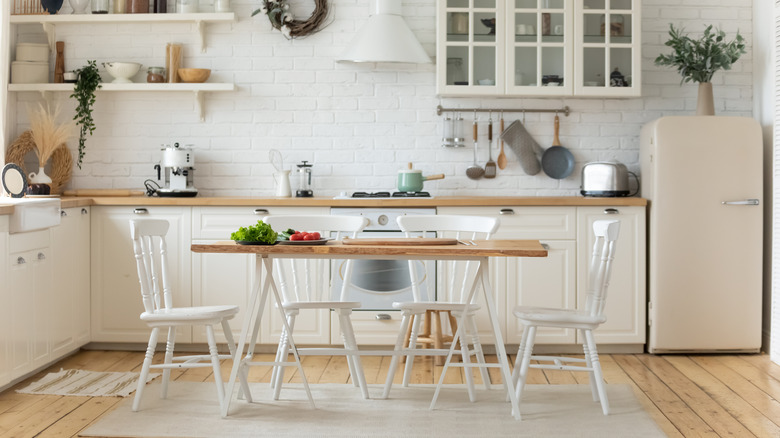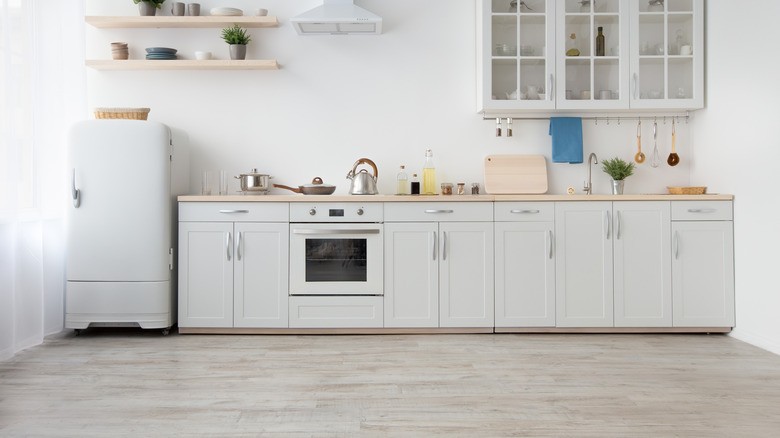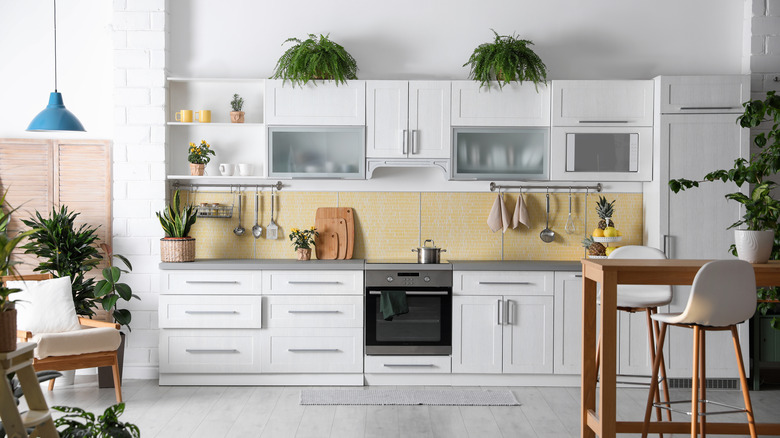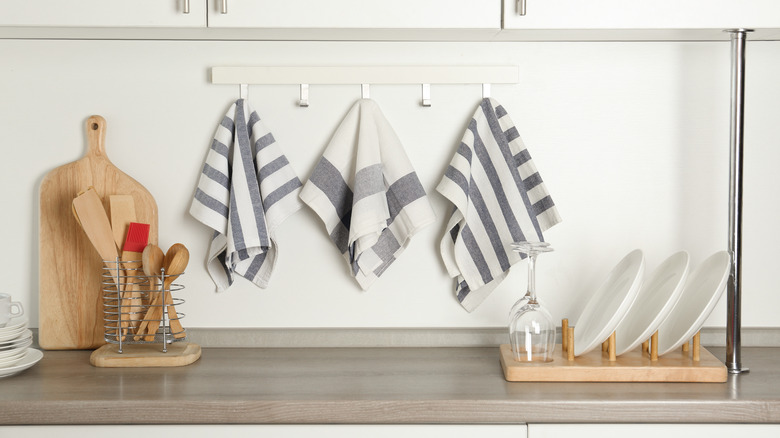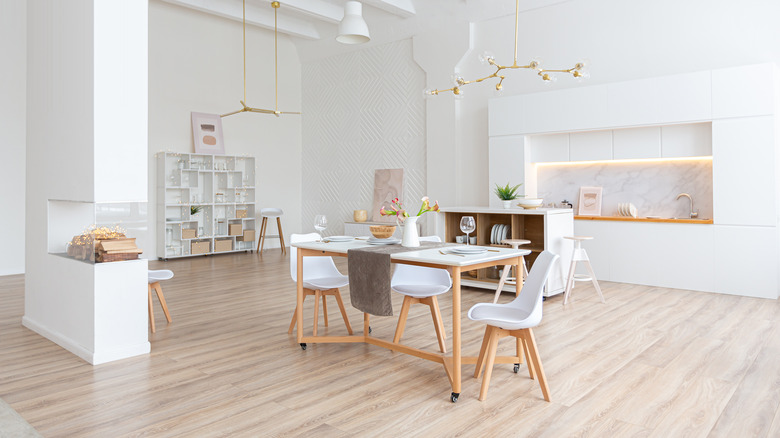How To Create The Perfect Nordic-Style Kitchen
One of the most classic, timeless, and easy-to-achieve design styles is Nordic or Scandinavian, referring to the region of Northern European countries that have a similar aesthetic approach. According to Scandinavian Standard, the design is largely defined by an overall dedication to minimalism, clean lines, simple neutral colors, and an emphasis on combining aesthetic value with practical value.
Nordic design goes wonderfully for more cluttered and chaotic rooms in your home, like your kitchen. It's a great way to make everything look and function in a simpler, more routine way while still looking gorgeous and clean. It's a very simple, modest aesthetic, with an emphasis on earthy tones, natural materials, and, in opposition to most minimalist designs, comfort and your lived experience. Popular materials include wood, glass, clay, and ceramic, as well as cotton and wool. Colors are primarily neutral, and those that aren't are more subdued in nature. Keep reading to learn how to transform your kitchen into a Nordic haven.
1. Wood countertops
Nordic design has a major emphasis on natural materials, chief among them being light-colored woods. There are various ways to incorporate wood in your kitchen — shelving, furniture, decoration — but few are as simultaneously trendy and classic as wood countertops.
Also known as butcher block countertops, wood countertops are a great way to lighten up and add some Nordic inspiration to your kitchen. Countertop Guides says the most popular woods used for counters are birch, teak, oak, cherry, or mahogany, but the best for Nordic design is either oak or bamboo. True to the design's principle, wood counters also have functional appeal, too. They tend to retain warmth better than materials like granite or marble, which is great for bakers. Be careful, though, as they're more susceptible to water and moisture damage, as well as scratching than other materials. Keep them clean and sealed, and you should be fine.
2. White and neutral shades
Nordic design is easily identifiable by its neutral, warm, and simple color palette. Yet again, this is as much of an aesthetic choice as it is a functional one. As Project Nord explains, winters in Nordic countries are very dark and long, which can lead to an overall dark and overbearing feeling in your home. Keeping your kitchen light, warm, and neutral helps create a slightly brighter environment in the darker months and reflects any light that does come in.
Generally, you should focus primarily, if not only, on soft or warm neutrals like gray, cream, beige, light blue, tan, and white. Don't go too warm on the cream and beige tones, and don't go too cool on gray or blue shades. If you want to incorporate some bolder colors, try and tone it down a little bit. Pink, for example, is a great warm color to incorporate in your Nordic kitchen, but opt for a dustier, pale rose shade as opposed to a brighter or more saturated tone.
3. Lots of houseplants
Unlike most minimalist aesthetics, Nordic and Scandinavian design is meant to feel homey and comfortable, focusing more on arranging things in a streamlined but still livable way than feeling ultra modern and sleek. One way to achieve this is through houseplants.
Because of the harsh winters, there are some plants that are quite popular and recurring in Nordic design. Some of the most popular and winter-hardy houseplants include orchids, philodendrons, chain cactuses, rubber plants, snake plants, and pothos, per Scandinavia Standard. Not only are these able to survive cooler and lower light conditions, but they also help purify the air. Another way to add some greenery to your kitchen in a functional way is to grow herbs. If you have a windowsill with adequate light, consider growing a few herbs, like basil, dill, mint, oregano, or thyme, recommends English Gardens. Don't be afraid to get creative and hang trailing plants from the tops of cabinets.
4. Natural textiles
Scandinavian design doesn't just emphasize the decorative being functional, but also the functional being decorative. Something as simple as your kitchen towels can have decorative and aesthetic value. Nordic design principles emphasize natural textiles and materials, including cotton, linen, and hemp.
Linen is among the most popular of those three, largely for its raw finish and sustainable production. Scandinavian Style House notes that it tends to be naturally less wrinkly with a coarser look and feel when compared to cotton. It's created by soaking flax plants in water, then stripping them of any woody, impure bits, spinning the pure remnants into linen. Linen is also naturally antiseptic, very durable, and absorbent, making it a great material to use for kitchen towels, aprons, etc. (per Varvara Home). Display them on a rack of hooks or pegs or using S hooks anywhere in your kitchen, like on a baker's rack or above your counters.
5. Bright and simple lighting
Lighting is another very important element of Scandinavian and Nordic design. With such long and dark winters, there's an emphasis on creating natural feeling light in simple, understated ways while emphasizing what natural light you do receive. Light colors and soft, natural textures help achieve this bright effect, but so does artificial light.
According to Scandinavia Standard, lights in your kitchen should emit warm and diffused light as opposed to stark and bright, clearly artificial light. When purchasing light bulbs for your light fixtures, make sure to look for warmer light bulbs instead of harsh and cool-toned ones. Also, consider more round and bulbous-shaped light fixtures and pendants, which will better diffuse and evenly radiate the light. Keep your fixtures simple and understated, but feel free to have a little bit of fun with modern design. For example, incorporate funky but simple shapes and unique wire designs.
